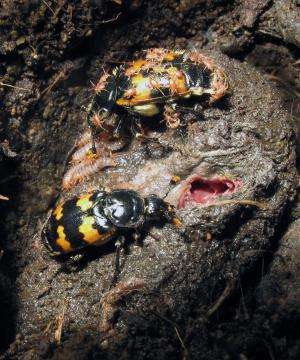NERC announces the winner of its first photo and essay competition

The winners of NERC's inaugural short article and photography competition were announced at an awards ceremony in central London this evening.
The winning essay, by Laura Hepburn of the University of Southampton, details the child-like excitement she felt during a recent research voyage when she first saw underwater hydrothermal vents blowing their signature black smoke across her monitoring screens. These are underwater fissures that erupt volcanic gasses and boiling water.
The winning photograph, by Paul Hopwood of the University of Exeter, is a disturbing, but eye-catching image of a pair of burying beetles processing an animal carcass.
Burying beetles
Burying beetles processing an animal carcass. Copyright Paul Hopwood. Click the photo to view the full image (196KB).
Essay entries were judged on the ability of applicants to communicate the excitement of their PhD research to a non-specialist audience, while the photography section was judged on eye-catching imagery and whether or not the image conveyed the applicants' research.
The entries, of which 67 were received, were independently ranked by the judges with the three highest ranking receiving a prize of up to £500.
Hepburn's highly descriptive writing style easily met all of the judging criteria. Her essay leads the reader on a journey that begins with a young inquisitive girl at an aquarium and ends with a competent researcher feeding the curious child still inside. Her PhD explores the geochemistry of these hydrothermal vents in the Southern Ocean.
Paul Hopwood's image demands the viewer do a double take as they realise the brightly coloured beetles aren't walking on mud, but on a carcass that the female of the pair is currently tearing apart, while the male looks after their offspring.
Hopwood is exploring how the parental environment experienced by burying beetle offspring affects their success and the parenting strategies they employ in the future.
The four judges on the panel were Jonathan Bates, Director of Communications for NERC, Harriet Jarlett, a science writer for NERC, Dr Helen Czerski, an oceanographer and TV presenter on popular science programmes, and Professor Simon Redfern.
Professor Redfern, a Professor of Mineral Physics at the University of Cambridge, who has recently worked with the BBC as a British Science Association Media Fellow, said, "Laura Hepburn's essay eloquently reflects on the wonder of scientific exploration. Her description of observations of the sea floor as part of a scientific cruise to the Southern Ocean rings as an echo of her early childhood curiosity - fascination with a deep-sea world that remains, for most of us, unknown and mysterious. She sheds light on what it means to be a scientist."
He continued, "Paul Hopwood's family portrait of burying beetles feasting may make you skin crawl, but it is difficult to take your eyes away from it. Mother and father are highlighted in a stream of light as they care for their brood of larvae, banqueting on decomposing carrion that forms the dark ground of this image. The glossy black and yellow carapace of the mother shines out, contrasting against the fleshy brood and their food, while the father labours under a burden of infesting mites. Are you enjoying your meal?!"
The runners-up were Christopher Darvill of the University of Durham, who was successful in both sections of the competition. His essay on conducting research on a desolate wind-carved part of South America came second; while the image of him being held up by the wind at his field site came third.
Third place in the essay section went to Dominic Cram, of the University of Exeter, for his description of catching and tagging birds in the Kalahari. And second place in the photo section went to Robin Wylie, of University College London, for his spectacular image of Mount Etna and its specific style of eruption.
Kirsty Grainger, Head of Skills & Careers at NERC, said, "We were delighted by the response to this inaugural competition. The diversity in the winning entries alone highlights the breadth of world-class research training NERC PhD funding supports. Congratulations to all the winners and thanks to all the judges and all those who submitted entries; the judges' task was not an easy one!"
Provided by Natural Environment Research Council



















